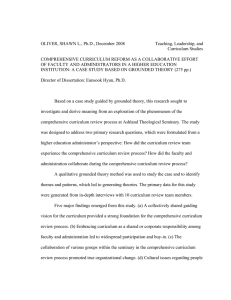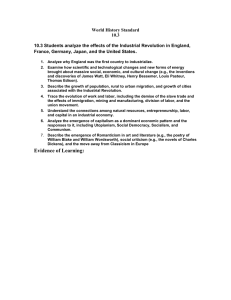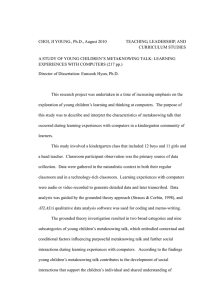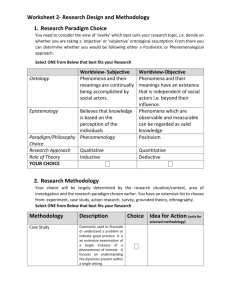Philosophical Paradigms, Grounded Theory, and Perspectives on Emergence
advertisement
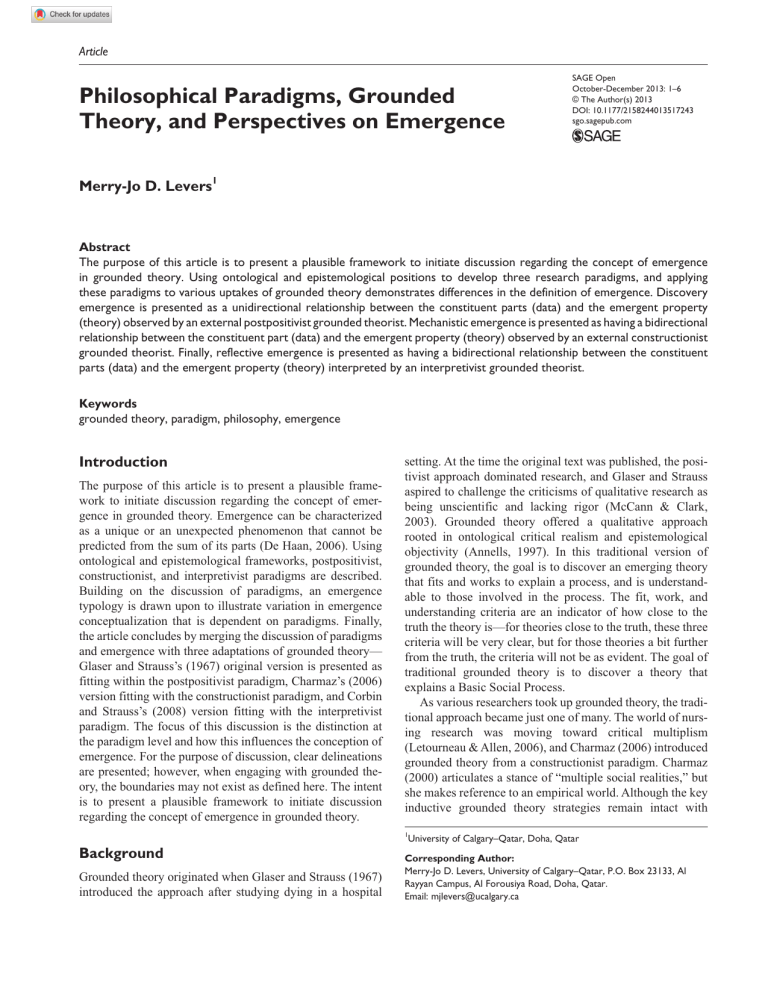
517243 research-article2013 SGOXXX10.1177/2158244013517243SAGE OpenLevers Article Philosophical Paradigms, Grounded Theory, and Perspectives on Emergence SAGE Open October-December 2013: 1­–6 © The Author(s) 2013 DOI: 10.1177/2158244013517243 sgo.sagepub.com Merry-Jo D. Levers1 Abstract The purpose of this article is to present a plausible framework to initiate discussion regarding the concept of emergence in grounded theory. Using ontological and epistemological positions to develop three research paradigms, and applying these paradigms to various uptakes of grounded theory demonstrates differences in the definition of emergence. Discovery emergence is presented as a unidirectional relationship between the constituent parts (data) and the emergent property (theory) observed by an external postpositivist grounded theorist. Mechanistic emergence is presented as having a bidirectional relationship between the constituent part (data) and the emergent property (theory) observed by an external constructionist grounded theorist. Finally, reflective emergence is presented as having a bidirectional relationship between the constituent parts (data) and the emergent property (theory) interpreted by an interpretivist grounded theorist. Keywords grounded theory, paradigm, philosophy, emergence Introduction The purpose of this article is to present a plausible framework to initiate discussion regarding the concept of emergence in grounded theory. Emergence can be characterized as a unique or an unexpected phenomenon that cannot be predicted from the sum of its parts (De Haan, 2006). Using ontological and epistemological frameworks, postpositivist, constructionist, and interpretivist paradigms are described. Building on the discussion of paradigms, an emergence typology is drawn upon to illustrate variation in emergence conceptualization that is dependent on paradigms. Finally, the article concludes by merging the discussion of paradigms and emergence with three adaptations of grounded theory— Glaser and Strauss’s (1967) original version is presented as fitting within the postpositivist paradigm, Charmaz’s (2006) version fitting with the constructionist paradigm, and Corbin and Strauss’s (2008) version fitting with the interpretivist paradigm. The focus of this discussion is the distinction at the paradigm level and how this influences the conception of emergence. For the purpose of discussion, clear delineations are presented; however, when engaging with grounded theory, the boundaries may not exist as defined here. The intent is to present a plausible framework to initiate discussion regarding the concept of emergence in grounded theory. setting. At the time the original text was published, the positivist approach dominated research, and Glaser and Strauss aspired to challenge the criticisms of qualitative research as being unscientific and lacking rigor (McCann & Clark, 2003). Grounded theory offered a qualitative approach rooted in ontological critical realism and epistemological objectivity (Annells, 1997). In this traditional version of grounded theory, the goal is to discover an emerging theory that fits and works to explain a process, and is understandable to those involved in the process. The fit, work, and understanding criteria are an indicator of how close to the truth the theory is—for theories close to the truth, these three criteria will be very clear, but for those theories a bit further from the truth, the criteria will not be as evident. The goal of traditional grounded theory is to discover a theory that explains a Basic Social Process. As various researchers took up grounded theory, the traditional approach became just one of many. The world of nursing research was moving toward critical multiplism (Letourneau & Allen, 2006), and Charmaz (2006) introduced grounded theory from a constructionist paradigm. Charmaz (2000) articulates a stance of “multiple social realities,” but she makes reference to an empirical world. Although the key inductive grounded theory strategies remain intact with 1 University of Calgary–Qatar, Doha, Qatar Background Grounded theory originated when Glaser and Strauss (1967) introduced the approach after studying dying in a hospital Corresponding Author: Merry-Jo D. Levers, University of Calgary–Qatar, P.O. Box 23133, Al Rayyan Campus, Al Forousiya Road, Doha, Qatar. Email: mjlevers@ucalgary.ca 2 Charmaz’s uptake of grounded theory, there is a shift away from the objective stance of the researcher and a recognition of the researchers role in constructing the data and theory. As the qualitative research world continues to move through the “moments” as defined by Denzin and Lincoln (2005), nursing research seems to be moving further away from the postpositivist paradigm and more toward the interpretivist paradigm. This movement is evident in Corbin and Strauss’s (2008) latest edition of Basics of Qualitative Research, although it must be acknowledged that this book is largely Corbin’s voice. This is an important fact because prior to this edition of the book, postpositivist tendencies were strongly evident in this uptake of grounded theory (Charmaz, 2000). Charmaz (2000) asserts the original position of Strauss and Corbin (1990) was one of an objective researcher who tries to represent an external reality as accurately as possible. This fits with ontological critical realism and epistemological objectivity; thus, the original publications would have fit better with the postpositive paradigm. A lack of critical debate exists in the grounded theory literature regarding the concept of emergence. One could conclude when discussing emergence in the context of grounded theory, there is conceptual uniformity because of this absence of debate. The only exception is the discussion regarding “forcing” fit rather than allowing fit to emerge (Duchscher & Morgan, 2004). Glaser (1978) is adamant that elements of the theory be allowed to organically emerge from the data through the grounded theory process, whereas Strauss and Corbin (1998) provide guidelines to assist with fitting the data. Glaser refers to this as “forcing,” whereas Strauss and Corbin refer to it as “a coding paradigm.” This debate is about “how-to” rather than “what is” emergence. Comparatively, most other concepts essential to grounded theory are systematically debated in a scholarly fashion. The content of this article is an initial step to encourage greater discourse regarding the concept of emergence in the context of grounded theory. SAGE Open Literature published over the last 45 years was reviewed for this article. Databases included CINAHL, OVID, Medline, EBSCOhost, and ScienceDirect. Search terms included “grounded theory,” “constructionist grounded theory,” “interpretivist grounded theory,” “emergence,” and “coding.” 2005, p. 183). Reality existing independent of human consciousness and experience, or reality existing within our consciousness and only through experience, is the eternal ontological debate. Do things exist independently of our mind, or is our world something constructed from our thoughts? For the purposes of this discussion, critical realist and relativist ontologies are presented as contrasting positions. These two perspectives represent the modern debate among researchers regarding reality—that of a single reality or multiple realities. Regardless of whether one positions herself with a single reality or multiple reality perspective, understanding the repercussions that fall from this anchoring point are critical. Critical realism is a contemporary uptake of the realist ontological perspective that reality exists independent of the human mind regardless of whether it is comprehendible or directly experienceable. In this ontology domain, ontological existence does not necessitate epistemological awareness. Critical realists believe there is a world that exists independent of the human mind but cannot be accessed in its entirety, rather only glimpses or partial fragments (Letourneau & Allen, 2006). The purpose of science from a critical realist perspective is to identify phenomena and develop agreement regarding the description of the whole from glimpses or partial fragments (Bergen, Wells, & Owen, 2010). Truth is achieved through reasoning rather than pure observation because only the results of causal forces may be observed rather than the causal forces themselves (Clark, MacIntyre, & Cruickshank, 2007). In other words, observation of an entity is not required to determine whether it exists. Relativist ontology is the belief that reality is a finite subjective experience (Denzin & Lincoln, 2005) and nothing exists outside of our thoughts. Reality from a relativist perspective is not distinguishable from the subjective experience of it (Guba & Lincoln, 2005). To state that the two cannot be separated is misleading because it implies there are two entities to separate. In this way of thinking, reality is human experience and human experience is reality. This is beyond two people experiencing an external world differently; rather, their worlds are different (Stajduhar, Balneaves, & Thorne, 2001). Universal “Truths” give way to negotiated truths in this antifoundational thought (Guba & Lincoln, 2005). With multiple interpretations of experience come multiple realities—there are as many different realities as there are people. The purpose of science from a relativist ontology is to understand the subjective experience of reality and multiple truths. Conceptual Terms Epistemology Ontology Epistemology, or the study of knowledge, is “a way of understanding and explaining how I know what I know” (Crotty, 1998, p. 3). According to Denzin and Lincoln (2005), epistemological inquiry looks at the relationship between the knower and the knowledge, and asks “how do I know the Data Sources “Ontology is the study of being” (Crotty, 1998, p. 10) and “raises basic questions about the nature of reality and the nature of the human being in the world” (Denzin & Lincoln, 3 Levers world?” (p. 183). Epistemology is about how I make meaningful sense of our world. Logically, ontological beliefs confine epistemological beliefs (Annells, 1996; Crotty, 1998), yet there is epistemological latitude within ontological delimitations. For example, believing that a world exists independently of awareness does not necessitate that meaning exists in the same way. For the purposes of this article, two opposing epistemological stances of objectivism and subjectivism are presented. Objectivism, as defined by Crotty (1998), is the belief that truth and meaning reside within an object and is independent of human subjectivity. Those declaring objectivity claim to remove all contextual factors to observe and know the phenomena as it exists independent of the human mind. Removal of human bias leads to the discovery of knowledge. What is being observed is not changed by the observer, nor is the observer being influenced by the observed. Adhering to an objectivist epistemology associated with a critical realist ontology as described here means that objects are believed to embody essences that are above and beyond the influence of humans, and these essences are discoverable through impartial observation. Knowledge is universally applicable because the essence of the object does not change regardless of who is studying the object. The goal of science is to discover the essences that reveal natural, universal laws of Truth (Nicholls, 2009). Finally, the purpose of knowledge from this epistemological standpoint is often used to explain, predict, and control (Grant & Giddings, 2002). Subjectivism is the belief that knowledge is “always filtered through the lenses of language, gender, social class, race, and ethnicity” (Denzin & Lincoln, 2005, p. 21). While not a denial that an external reality exists, a subjective epistemology recognizes knowledge as value laden. Unaffected and universal knowledge of an external reality is not possible beyond individual reflections and interpretations. Observations are influenced by the observer and the observer is influenced by the observed. An example of subjective knowledge is the image of a Rubin Vase that can be interpreted as either a white vase on a black background or two persons facing each other. The image perceived is dependent on the person perceiving—there is no right or wrong image. The goal of subjective research is to develop understanding, increase sensitization to ethical and moral issues, and personal and political emancipation (Denzin & Lincoln, 2005). Paradigms “To ensure a strong research design, researchers must choose a research paradigm that is congruent with their beliefs about the nature of reality” (Mills, Bonner, & Francis, 2006, p. 2). Paradigm refers to “a system of ideas, or world view, used by a community of researchers to generate knowledge. It is a set of assumptions, research strategies and criteria for rigour that are shared, even taken for granted by that community” (Fossey, Harvey, McDermott, & Davidson, 2002, p. 718). Denzin and Lincoln (2005) define paradigms as the researcher’s “net” that holds the ontological, epistemological, and methodological beliefs, and refer to the “taken for granted” aspects of a paradigm as “first principles, or ultimates” (p. 183). In addition, while there is some room for debate within a specific paradigm, consensus is strong overall (Clark, 1998). For the purposes of this article, the postpositivist, constructionist, and interpretivist paradigms will be explored. I chose these paradigms to reflect the movement in qualitative research away from a foundationalist to antifoundationalist research (Denzin & Lincoln, 2005). Postpositivist The postpositivist paradigm is conceptualized as having an objectivist epistemology and critical realist ontology (Annells, 1997). “Critical implies that, as in positivism, the need for rigour, precision, logical reasoning and attention to evidence is required, but unlike positivism, this is not confined to what can be physically observed” (Crossan, 2003, p. 53). Postpositivists believe that maintaining the certainty that absolute truth is discoverable through science is untenable in today’s world (Letourneau & Allen, 2006). This paradigm accepts that truth and universal laws exist but discovery of these truths is near impossible. Postpositivists expect to progress closer to the truth while recognizing that discoveries are only partial segments or approximations of truth (Clark, 1998). Due to its critical realist ontology, postpositivist scholars accept that knowledge is fallible because it is shaped by contextual influences (McEvoy & Richards, 2003), but trusting that objective investigation will bring us closer to the truth. Interpretivist In opposition to the postpositivist paradigm is the interpretivist paradigm, which is conceptualized as having a relativist ontology with a subjectivist epistemology and is aligned with postmodern thought. Interpretivist research “is guided by the researcher’s set of beliefs and feelings about the world and how it should be understood and studied” (Denzin & Lincoln, 2005, p. 22). In the interpretive paradigm, “knowledge is relative to particular circumstances—historical, temporal, cultural, subjective—and exists in multiple forms as representations of reality (interpretations by individuals)” (Benoliel, 1996, p. 407). Interpretivists accept multiple meanings and ways of knowing, and acknowledge “objective reality can never be captured. I only know it through representations” (Denzin & Lincoln, 2005, p. 5). The interpretive paradigm focuses primarily on recognizing and narrating the meaning of human experiences and actions (Fossey et al., 2002). Constructionist Finally, the constructionist paradigm is conceptualized as having aspects of both the postpositivist and interpretivist 4 paradigms—ontological critical realism with epistemological subjectivism. Meaning is created through an interaction of the interpreter and the interpreted (Crotty, 1998). The interpreter, though not entirely objective, is separate from the phenomena to be observed and the meaning-making interaction is strongly influenced by the phenomena and society. More pointedly, it is not simply the researcher’s interpretation, rather the phenomena affects the interpretation with equal force. How the interpreter conceptualizes and understands the thing to be interpreted cannot be approached as a blank state with the goal of observing something in its true form. Rather, the interpreter’s observations are shaped by the phenomena and societal influences, and the interpreter is aware that her interpretations are influenced and does not claim to be discovering Truth. Furthermore, she acknowledges that the findings are a construct produced by the interaction between the interpreter and the interpreted as situated in society. Knowledge of the observed is constructed rather than discovered. Emergence There seems to be a generalized agreement that emergence refers to an entity that is “more than the sum of its parts.” The summation takes on novel properties and traits that do not exist at a lower level and is not necessarily predictable (Jost, Berschinger, & Olbrich, 2010). For example, a snowflake is an unpredictable pattern that emerges from frozen water particles, the flight pattern unpredictable from a flock of birds, or a hurricane unpredictable from air and water molecules. Within the philosophical literature about emergence, there are opposing views regarding definition and existence (Jost et al., 2010; Kim, 2006). The work of De Haan (2006) is valuable for reflecting on the possible variations of emergence conceptualizations when using a grounded theory approach. Defining emergence as an object or phenomena that transcends the thing that produces it, De Haan (2006) strives to produce a typology that will be useful across all disciplines. This typology is helpful when discussing the concept of emergence in relationship to the various uptakes of grounded theory. Key to this framework is the positionality of the observer (internal or external) and the conjugate (unidirectional or bidirectional). An observer is separate from both the emergent property and its constituent parts (external) or is part of the system and has a relationship with both the constituent parts and the emergent property (internal). Conjugate is the term De Haan uses to describe the relationship between the emergent property and its constituent parts. This includes a unidirectional relationship from its constituent parts to the emergent property or a bidirectional relationship in which the emergent property is the result of but interdependent with its constituent parts. The variation in observer and conjugate result in a typology of emergence De Haan labels as discovery, mechanistic, and reflective. Discovery emergence necessitates an external observer and a unidirectional conjugate. For this category, emergence SAGE Open has no causal effect on the system that produced it and the observer is external to the process. Due to the objectivity of the researcher, the emergence being observed is an entity that exists external to the observer’s mind. The second emergence category is mechanistic in which the observer is external but acknowledges a bidirectional relationship between the emergent property and the constituent parts. Not only are the constituent parts resulting in an emerging property but the emergent property also has a reciprocal effect on its constituent parts. The observer, while remaining external to the process, recognizes this reciprocal relationship. Finally, the last category is reflective emergence for which the observer is internal and is a constituent part that is producing the emergence. The conceptualization of the emergence is relative to the observer’s subjective experience. Implications for Nursing Grounded theory is one of the most utilized qualitative approaches in nursing research (Schreiber & Stern, 2001). Since Glaser and Strauss’s (1967) original publication, many versions of grounded theory have been introduced. For the purposes of this article, I touch on three of these variations— Glaser and Strauss, Charmaz (2006), and Corbin and Strauss (2008). Postpositivist Emergence The traditional uptake of grounded theory fits with the postpositivist paradigm as described here. In the postpositivist paradigm, the researcher approaches grounded theory with the understanding that reality exists external to herself and the research participants. Objectivity results in discovering an emergent theory that simplifies the categories and properties that are not predictable from the apparent erratic patterns noted in the data. The researcher approaches the data with an impartial mind-set, and through constant comparative method will discern regularities where chaos previously existed. The regularities will emerge as a theory that transcends and simultaneously simplifies the data. Emergence in grounded theory approached from a postpositivist paradigm fits well with De Haan’s (2006) discover typology. In both the postpositivist approach and “Discovery” emergence, the researcher is external to the process and is an observer rather than a creator or participant. The researcher remains “open to what is actually happening” (Glaser, 1978, p. 3) without forcing the data (constituent parts) to fit the theory (emergent property). Identification of this theory can only be done if the researcher maintains a stance of objectivity and allow for participants perspectives to come through rather than the researchers (Glaser, 1978). Approaching the data with a general sense of wonderment (Glaser, 1978), the researcher removes her influence on the data and allows the theory to emerge in its true sense. The researcher observes the emergence of a theory that transcends and simplifies the data. The emergent theory is an imperfect apprehension of 5 Levers reality, and it is one of many theories that could emerge as research moves closer to the “real” reality (Annells, 1997). Constructionist Emergence According to Charmaz (2000), her approach to grounded theory “recognizes mutual creation of knowledge by the viewer and the viewed” (p. 510). Research from a constructionist paradigm acknowledges that “truth or meaning comes into existence in and out of our engagement with the realities in our world” (Crotty, 1998, p. 8). By separating the viewer and the viewed, and acknowledging that meaning comes from the interaction of the two, Charmaz (2006) is indicating the viewed exists outside of the viewers mind and that meaning is dependent on, or relative to, the interaction of the viewer and the viewed. Hence, this can be interpreted to indicate a critical realist ontology and a relativist epistemology; thus, Charmaz’s “constructivist” approach to grounded theory fits with the constructionist paradigm as described. Emergence in the constructionist paradigm is observed differently than the discovery emergence in the postpositivist paradigm. Having a critical realist ontology implies there is a real world which the participants and the researcher are able to access in bits and pieces. The bits and pieces come together to form and explain the data and the theory, but neither the theory nor the data are true representations of reality. Concurrently, having a subjectivist epistemology means recognition on the part of the researcher that she cannot understand the data from a purely objective stance so she begins to construct a theory that will simplify the complexity found in the data. Unfortunately, having this conundrum of ontological and epistemological beliefs does not fit clearly with any of De Haan’s (2006) emergence typologies. Although the researcher is not fully external to the process of emergence because she is actively constructing the theory, she is not part of the constituent elements in that she acknowledges a world that exists outside of her mind. There is a relationship that exists between the constituent elements and the emergence through her, yet she is not a constituent element. She is external to the data yet internal to the emergence because there is a relationship between the data and the emergence through the researcher. The data influence how the researcher constructs the emerging theory and the emerging theory influences how the researcher interprets the data, and all of this process is influenced by societal structures. Distinguishing emergence in the constructivist paradigm implies the researcher will construct a theory that reduces the complexity found in the data, has a nonlinear relationship with the data, and is an independent entity. Furthermore, the researcher will acknowledge that as this theory emerges, it is influenced by how the researcher is interpreting the data, and the interpretation of the data is strongly influenced by the emerging theory. This understanding of emergence fits, admittedly with a bit of force, with De Haan’s (2006) mechanistic typology. There is a conjugate relationship in which the emergent theory and its constituent parts have an effect on each other. The observer, while acknowledging influences on her observance of the emergent theory, tries to remain as objective as possible. While not completely external to the process of emergence, the researcher tries to observe the theory emerging while acknowledging there is a relationship between the emerging theory and its constituent parts because she is not able to remove herself completely to watch the process from an external standpoint. Interpretivist Emergence In the third edition of the Basics of Qualitative Research: Techniques and Procedures for Developing Grounded Theory (Corbin & Strauss, 2008), Corbin takes the introductory chapter to explain her ontological and epistemological assumptions that fit with the interpretivist paradigm as described here. Corbin (Corbin & Strauss, 2008) acknowledges that she is approaching grounded theory from a relativist ontology by stating, “I realize there is no one ‘reality’ out there waiting to be discovered” (p. 10), and reality under no circumstances is able to be fully understood or reconstructed by a researcher. Epistemologically, Corbin indicates subjectivity by stating that is not possible to “separate who I am as a person from the research and analysis that I do” (p. 11), and furthermore, “meaning does not come out of an interplay between subject and object but is imposed on the object by the subject” (p. 9). Because the meaning is coming entirely from the subject, the epistemological foundation is clearly subjective. Emergence in the interpretive paradigm fits with De Haan’s (2006) reflective typology. The researcher is internal to the process of emergence by participating as a constituent element in the creation of emergence. Emergence in this approach has a bidirectional conjugate relationship with the researcher, and the researcher is part of the system that gives life to the emergent property. The relative ontological stance accompanied by a subjectivist epistemology supports the researcher identifying, defining, and being part of the constituent parts and the emergent property. Unlike the previous two versions of grounded theory, this version does not consider reality to be something that exists outside of the researcher. The emerging theory is unquestionably the researcher’s unfettered interpretation of the data that is unhindered by an external reality. Conclusion The purpose of this article was to present a plausible framework to initiate discussion regarding the concept of emergence in grounded theory. A plausible structure connecting the researchers’ paradigmatic uptake of grounded theory and how this affects emergence is presented. Using opposing ontological and epistemological beliefs, a framework of 6 postpositivist, constructionist, and interpretivist approaches to research initiates the discussion. Next, using the framework is used to connect three versions of grounded theory and explore how the concept of emergence could be deliberated. Although a clear fit for both discovery and reflective typologies was considered, an uncertain fit with the mechanistic emergence was debated. As indicated at the beginning of this article, the delimitations of the framework are blurry. The purpose in presenting this framework was to initiate scholarly debate regarding how emergence could be conceptualized depending on how grounded theory is taken up by the researcher. This will expand on the current “forcing versus fit” debate that exists in the grounded theory literature and begin the much needed debate regarding emergence in the research methodology. Declaration of Conflicting Interests The author(s) declared no potential conflicts of interest with respect to the research, authorship, and/or publication of this article. Funding The author(s) received no financial support for the research and/or authorship of this article. References Annells, M. (1996). Grounded theory method: Philosophical perspectives, paradigm of inquiry, and postmodernism. Qualitative Health Research, 6, 705-713. Annells, M. (1997). Grounded theory method, part I: Within the five moments of qualitative research. Nursing Inquiry, 4, 120129. Benoliel, J. Q. (1996). Grounded theory and nursing knowledge. Qualitative Health Research, 6, 406-428. Bergen, M., Wells, J. S. G., & Owen, S. (2010). Relating realist metatheory to issues of gender and mental health. Journal of Psychiatric and Mental Health Nursing, 17, 442-451. Charmaz, K. (2000). Grounded theory: Objectivist and constructionist methods. In N. K. Denzin, & Y. S. Lincoln (Eds.), The sage handbook of qualitative research (2nd ed., pp. 509-533). Thousand Oaks, CA: Sage. Charmaz, K. (2006). Constructing grounded theory: A practical guide through qualitative analysis. Thousand Oaks, CA: Sage. Clark, A. M. (1998). The qualitative-quantitative debate: Moving from positivism and confrontation to post-positivism and reconciliation. Journal of Advanced Nursing, 27, 1242-1249. Clark, A. M., MacIntyre, P. D., & Cruickshank, J. (2007). A critical realist approach to understanding and evaluating heart health programmes. Health: An interdisciplinary journal for the social study of health, illness, and medicine, 11, 513-539. Corbin, J. M., & Strauss, A. L. (2008). Basics of qualitative research: Techniques and procedures for developing grounded theory (3rd ed). Thousand Oaks, CA: Sage. Crossan, F. (2003). Research philosophy: Towards an understanding. Nurse Researcher, 11(1), 46-55. Crotty, M. (1998). The foundation of social research: Meaning and perspective in the research process. Thousand Oaks, CA: Sage. De Haan, J. (2006). How emergence arises. Ecological Complexity, 3, 293-301. SAGE Open Denzin, N. K., & Lincoln, Y. S. (2005). Introduction: The discipline and practice of qualitative research. In N. Denzin, & Y. Lincoln (Eds.), The SAGE handbook of qualitative research (3rd ed., pp. 1-32). Thousand Oaks, CA: Sage. Duchscher, J. E., & Morgan, D. (2004). Grounded theory: Reflections on the emergence vs. forcing debate. Journal of Advanced Nursing, 48, 605-612. Fossey, E., Harvey, C., McDermott, F., & Davidson, L. (2002). Understanding and evaluating qualitative research. Australian and New Zealand Journal of Psychiatry, 36, 717-732. Glaser, B. G. (1978). Theoretical sensitivity. Mill Valley, CA: Sociology Press. Glaser, B. G., & Strauss, A. L. (1967). The discovery of grounded theory: Strategies for qualitative research. New Brunswick, NJ: Aldine. Grant, B. M., & Giddings, L. S. (2002). Making sense of methodologies: A paradigm framework for the novice researcher. Contemporary Nurse: A Journal for the Australian Nursing Profession, 13(1), 10-28. Guba, E. E., & Lincoln, Y. S. (2005). Paradigmatic controversies, contradictions, and emerging confluences. In N. Denzin, & Y. Lincoln (Eds.), The SAGE handbook of qualitative research (3rd ed., pp. 191-216). Thousand Oaks, CA: Sage. Jost, J., Berschinger, N., & Olbrich, E. (2010). Emergence. New Ideas in Psychology, 28, 265-273. Kim, J. (2006). Emergence: Core ideas and issues. Synthese, 151, 547-559. Letourneau, N., & Allen, M. (2006). Post-positivistic critical multiplism: A beginning dialogue. In W. K. Cody (Ed.), Philosophical and theoretical perspectives for advanced nursing practice (pp. 221-231). Boston, MA: Jones and Bartlett Publishers. McCann, T. V., & Clark, E. (2003). Grounded theory in nursing research: Part 1—Methodology. Nurse Researcher, 11(2), 718. McEvoy, P., & Richards, D. (2003). Critical realism: A way forward for evaluation research in nursing? Journal of Advanced Nursing, 43, 411-420. Mills, J., Bonner, A., & Francis, K. (2006). The development of constructivist grounded theory. International Journal of Qualitative Methods, 5(1), 1-10. Nicholls, D. (2009). Qualitative research: Part one-philosophies. International Journal of Therapy and Rehabilitation, 16, 526533. Schreiber, R. S., & Stern, P. N. (2001). Using grounded theory in Nursing. New York, YN: Springer. Stajduhar, K. I., Balneaves, L., & Thorne, S. E. (2001). A case for the “middle ground”: Exploring the tensions of postmodern thought in nursing. Nursing Philosophy, 2, 72-82. Strauss, A. L., & Corbin, J. (1990). The basics of qualitative analysis: Grounded theory procedures and techniques (1st ed.). Newbury Park, CA: Sage. Strauss, A. L., & Corbin, J. (1998). The basics of qualitative research: Techniques and procedures for developing grounded theory (2nd ed.). Newbury Park, CA: Sage. Author Biography Merry-Jo D. Levers, MN, PhD(c), is a nursing instructor at University of Calgary–Qatar in Doha, Qatar. She is also a PhD candidate at the University of Victoria in Victoria, Canada.
